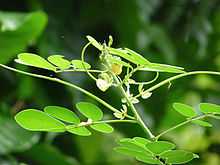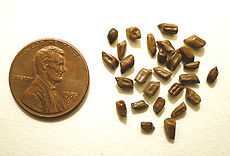Senna obtusifolia
| Senna obtusifolia | |
|---|---|
 | |
| Senna obtusifolia | |
| Conservation status | |
| Scientific classification | |
| Kingdom: | Plantae |
| (unranked): | Angiosperms |
| (unranked): | Eudicots |
| (unranked): | Rosids |
| Order: | Fabales |
| Family: | Fabaceae |
| Subfamily: | Caesalpinioideae |
| Tribe: | Cassieae |
| Subtribe: | Cassiinae |
| Genus: | Senna |
| Species: | S. obtusifolia |
| Binomial name | |
| Senna obtusifolia (L.) H.S.Irwin & Barneby | |
| Synonyms | |
|
Numerous, see text | |
Senna obtusifolia (Chinese senna, American sicklepod[1] or sicklepod) is a legume in the genus Senna, sometimes separated in the monotypic genus Diallobus. It grows wild in North, Central, and South America, Asia, Africa, and Oceania, and is considered a particularly serious weed in many places. It has a long-standing history of confusion with Senna tora and that taxon in many sources actually refers to the present species.
The green leaves of the plant are fermented to produce a high-protein food product called "kawal" which is eaten by many people in Sudan as a meat substitute.[2] Its leaves, seeds, and root are also used in folk medicine, primarily in Asia. It is believed to possess a laxative effect, as well as to be beneficial for the eyes. As a folk remedy, the seeds are often roasted, then boiled in water to produce a tea. The plant's seeds are a commercial source of cassia gum, a food additive usually used as a thickener and named for the Chinese Senna's former placement in the genus Cassia. Roasted and ground, the seeds have also been used as a substitute for coffee. In traditional Korean medicine, they are called gyeolmyeongja (결명자) and usually prepared as tea. They are also used in Kampō (traditional Japanese medicine), where they are called ketsumei-shi (ケツメイシ, 決明子) or by their Chinese name jué míng zǐ (traditional: 決明子, simplified: 决明子).
Names, taxonomy and identifier
Apart from "sicklepod" and "Chinese senna", S. obtusifolia has a wide range of common names. It is also known in English as Foetid Sassia (or "cassia"), Sickle Senna, Coffeeweed or Arsenic Weed, and somewhat ambiguously as "blunt-leaved senna", "coffee pod" or "java bean". The scientific name means "blunt-leaved senna", with obtusifolia coming from Latin obtusus ("dull", "blunt") + folium ("leaf").
Names in its native range are also:
- Chinese: pinyin: jué míng zi (simplified Chinese: 决明子; traditional Chinese: 決明子)
- Japanese: ebisu-gusa ("Ebisu grass": エビスグサ; 胡草; 恵比須草)
- Korean: gyeolmyeongja (hangul: 결명자; hanja: 決明子)
- Portuguese: fedegoso (also used for Senna macranthera and others)
- Hindi: chirauta chokad
- Vietnamese: quyết minh tử
Synonyms

Chinese Senna has been treated under a wide range of scientific names. Some are synonyms of Senna obtusifolia, others are names that have been applied to it in error. In addition, several of these names may also refer to related plants. In particular, the distinction between this species and Senna tora was fraught with errors and misunderstandings:[3]
- Cassia humilis Collad.
- Cassia humilis Steud. is a synonym of Chamaecrista kunthiana
- Cassia numilis Collad. is apparently a misprint and refers to Senna tora
- Cassia obtusifolia L.
- Cassia tora auct. non L.
- Cassia tora L. is a synonym of Senna tora
- Cassia tora L. var. b Wight & Arn.
- Cassia tora L. var. humilis (Collad.) Collad.
- Cassia tora L. var. obtusifolia (L.) Haines
- Cassia toroides Raf.
- Cassia toroides Roxb.
- Diallobus falcatus Raf.
- Diallobus uniflorus Raf.
- Senna toroides Roxb.
- Senna obtusifolia - Jue ming zi in Chinese
Meat substitute
Kawal, a protein-rich meat substitute eaten in Sudan, is produced by crushing the leaves of the plant into a paste which is then traditionally fermented in an earthenware jar, buried in a cool place. The jar is dug up every three days and the contents mixed. After two weeks, the paste is removed and rolled into balls which are left to dry in the sun. They are usually cooked in stews with onions and okra.[2][4]
In literature
This plant is a conspicuous member of the flora of its native home. It evoked powerful images to the celebrated Tang Dynasty poet Du Fu (杜甫), who in one of his "Sighs of Autumn Rain" poems (Qiū yǔ tàn, 秋雨叹) discussed it thus:[5]
In autumn rain, the grasses rot and die, / Below the steps, the Chinese Senna's colour is fresh.
Upstairs the scholar lets down his white hair, / He faces the wind, breathes the fragrance, and weeps.
Full green leaves cover the stems like feathers, / And countless flowers bloom like golden coins.
The cold wind, moaning, blows against you fiercely, / I fear that soon you'll find it hard to stand.
Footnotes
- ↑ "BSBI List 2007" (xls). Botanical Society of Britain and Ireland. Retrieved 2014-10-17.
- ↑ 2.0 2.1 Dirar, Hamid (1 July 1984). "Kawal, meat substitute from fermented Cassia obtusifolia leaves". Economic Botany (Springer New York) 38 (3): 342–349. doi:10.1007/bf02859013. ISSN 0013-0001. JSTOR 3793107.
- ↑ ILDIS (2005), USDA (2007)
- ↑ "Plants that provide a protein-rich diet". New Scientist 107 (1468): 30. 8 August 1985. ISSN 0028-6664.
- ↑ Chinese Poems.com: Sighs of Autumn Rain (1). Retrieved 2007-DEC-20.
雨中白草秋烂死,阶下决明颜色鲜。
著叶满枝翠羽盖,开花无数黄金钱。
凉风萧萧吹汝急,恐汝后时难独立。
堂上书生空白头,临风三嗅馨香泣。
References
- International Legume Database & Information Service (ILDIS) (2005): Genera Cassia and Senna. Version 10.01, November 2005. Retrieved 2007-DEC-17.
- United States Department of Agriculture (USDA) (2007): Germplasm Resources Information Network - Senna obtusifolia. Retrieved 2007-DEC-20.
External links
| Wikimedia Commons has media related to Senna obtusifolia. |
- Cassia Seed page from ENaturalHealthCenter.com site
- Photos from Missouriplants.com site
